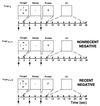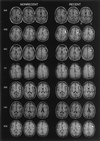The neural substrate and temporal dynamics of interference effects in working memory as revealed by event-related functional MRI - PubMed (original) (raw)
The neural substrate and temporal dynamics of interference effects in working memory as revealed by event-related functional MRI
M D'Esposito et al. Proc Natl Acad Sci U S A. 1999.
Abstract
Research on the prefrontal cortex (PFC) of monkeys and humans indicates that this region supports a heterogeneous repertoire of mental processes that contribute to many complex behaviors, such as working memory. Anatomical evidence for some of these processes derives from functional neuroimaging experiments using blocked experimental designs, which average signal across all components of many trials and therefore cannot dissociate distinct processes with different time courses. Using event-related functional MRI, we were able to isolate temporally the neural correlates of processes contributing to the target presentation, delay, and probe portions of an item-recognition task. Two types of trials were of greatest interest: those with Recent Negative probes that matched an item from the target set of the previous, but not the present, two trials, and those with Nonrecent Negative probes that did not match a target item from either the present or the two previous trials. There was no difference between the two trial types in target presentation (i.e., encoding) or delay-period (i.e., active maintenance) PFC activation, but there was significantly greater activation for Recent Negatives than Nonrecent Negative activation associated with the probe period within left ventrolateral PFC. These findings characterize spatially and temporally a proactive interference effect that may reflect the operation of a PFC-mediated response-inhibition mechanism that contributes to working memory performance.
Figures
Figure 1
Schematic illustration of the item-recognition task. Each trial lasted 9.5 sec followed by a 14.4-sec intertrial interval. Target items were presented for 950 msec followed by a 7,050-msec delay period. This interval was followed by a probe letter for 1,500 msec that either was recently presented (Recent trial) or was not recently presented (Nonrecent trial). Note that, in the Recent Negative trial, the probe letter “P” is not in the target set of that trial but that it is in the target set of the two previous trials. The arrows along the time line represent the placement of independent variables positioned to detect variance in the fMRI signal associated with target presentation, delay period, and probe portions of the trial, respectively.
Figure 2
Pattern of activation with each of the task components. Shown are axial slices encompassing the ventral PFC ROI (white circles) in a representative subject (WB). Significantly greater activation (relative to the intertrial interval) is seen during the Recent Negative trials as compared with the Nonrecent Negative trials during the Probe period and not during the presentation of the Target or during the Delay period.
Figure 3
Pattern of activation within the probe period of the task. Shown are axial slices encompassing the ventral PFC ROI (white circles) in each subject showing activation in the Recent Negative and Nonrecent Negative trials.
Figure 4
Trial averaged time series. Shown are the trial-averaged time series data for a representative subject extracted from voxels demonstrating a main effect for the Probe period across both Recent Negative and Nonrecent Negative trials. Activity in the two conditions differed statistically only during the Probe portion of the task (see arrow).
Similar articles
- Sustained and transient neural modulations in prefrontal cortex related to declarative long-term memory, working memory, and attention.
Marklund P, Fransson P, Cabeza R, Petersson KM, Ingvar M, Nyberg L. Marklund P, et al. Cortex. 2007 Jan;43(1):22-37. doi: 10.1016/s0010-9452(08)70443-x. Cortex. 2007. PMID: 17334205 - Prefrontal cortex and the mediation of proactive interference in working memory.
Postle BR, Brush LN, Nick AM. Postle BR, et al. Cogn Affect Behav Neurosci. 2004 Dec;4(4):600-8. doi: 10.3758/cabn.4.4.600. Cogn Affect Behav Neurosci. 2004. PMID: 15849900 Free PMC article. - [Active consciousness and the prefrontal cortex: a working-memory approach].
Osaka N. Osaka N. Shinrigaku Kenkyu. 2007 Feb;77(6):553-66. doi: 10.4992/jjpsy.77.553. Shinrigaku Kenkyu. 2007. PMID: 17447465 Review. Japanese. - Prefrontal cortex and long-term memory encoding: an integrative review of findings from neuropsychology and neuroimaging.
Blumenfeld RS, Ranganath C. Blumenfeld RS, et al. Neuroscientist. 2007 Jun;13(3):280-91. doi: 10.1177/1073858407299290. Neuroscientist. 2007. PMID: 17519370 Review.
Cited by
- Structural and diffusion-weighted brain imaging predictors of attention-deficit/hyperactivity disorder and its symptomology in very young (4- to 7-year-old) children.
Öztekin I, Garic D, Bayat M, Hernandez ML, Finlayson MA, Graziano PA, Dick AS. Öztekin I, et al. Eur J Neurosci. 2022 Dec;56(12):6239-6257. doi: 10.1111/ejn.15842. Epub 2022 Nov 1. Eur J Neurosci. 2022. PMID: 36215144 Free PMC article. - Memory and Proactive Interference for spatially distributed items.
Endress AD. Endress AD. Mem Cognit. 2022 May;50(4):782-816. doi: 10.3758/s13421-021-01239-1. Epub 2022 Feb 4. Mem Cognit. 2022. PMID: 35119628 Free PMC article. - Staying cool when things get hot: emotion regulation modulates neural mechanisms of memory encoding.
Hayes JP, Morey RA, Petty CM, Seth S, Smoski MJ, McCarthy G, Labar KS. Hayes JP, et al. Front Hum Neurosci. 2010 Dec 22;4:230. doi: 10.3389/fnhum.2010.00230. eCollection 2010. Front Hum Neurosci. 2010. PMID: 21212840 Free PMC article. - Prefrontal mechanisms for executive control over emotional distraction are altered in major depression.
Wang L, LaBar KS, Smoski M, Rosenthal MZ, Dolcos F, Lynch TR, Krishnan RR, McCarthy G. Wang L, et al. Psychiatry Res. 2008 Jul 15;163(2):143-55. doi: 10.1016/j.pscychresns.2007.10.004. Epub 2008 May 1. Psychiatry Res. 2008. PMID: 18455373 Free PMC article. - Double dissociation of working memory load effects induced by bilateral parietal modulation.
Sandrini M, Fertonani A, Cohen LG, Miniussi C. Sandrini M, et al. Neuropsychologia. 2012 Feb;50(3):396-402. doi: 10.1016/j.neuropsychologia.2011.12.011. Epub 2011 Dec 27. Neuropsychologia. 2012. PMID: 22223077 Free PMC article. Clinical Trial.
References
- Fuster J. The Prefrontal Cortex: Anatomy, Physiology, and Neuropsychology of the Frontal Lobes. New York: Raven; 1997.
- Owen A M, Evans A C, Petrides M. Cereb Cortex. 1996;6:31–38. - PubMed
- D’Esposito, M., Postle, B. R., Ballard, D. & Lease, J. (1999) Brain Cognit., in press. - PubMed
- D’Esposito M, Postle B R. In: Attention and Performance XVIII. Monsell S, Driver J, editors. Cambridge, MA: MIT Press; 1999. , in press.
- D’Esposito, M. & Postle, B. R. (1999) Neuropsychologia, in press. - PubMed
Publication types
MeSH terms
LinkOut - more resources
Full Text Sources
Medical
Miscellaneous



